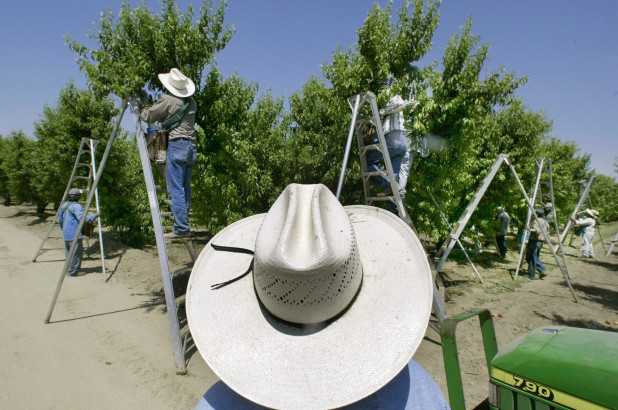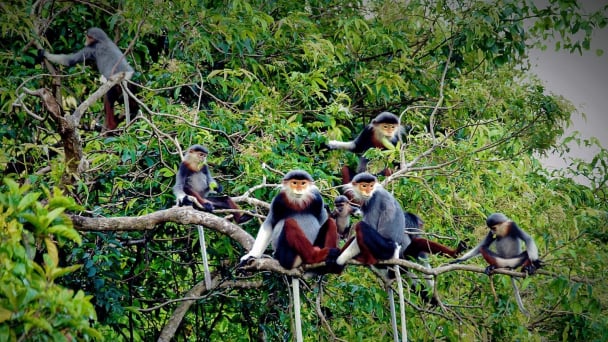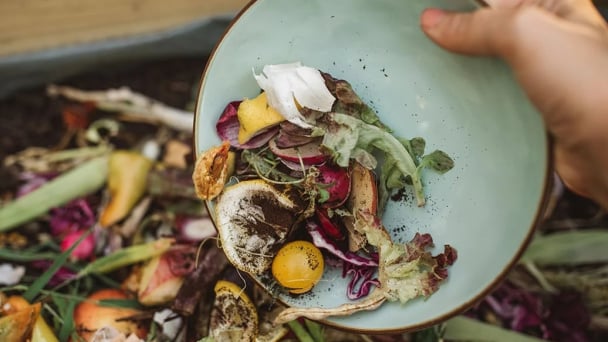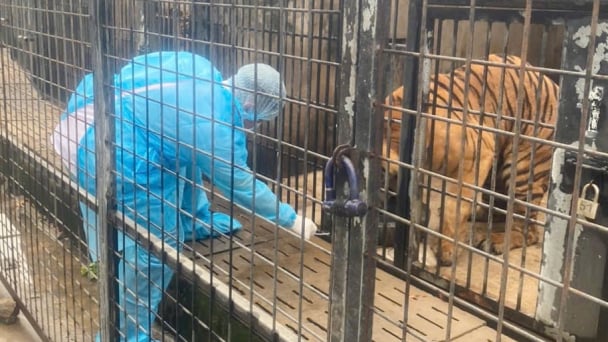May 17, 2025 | 15:13 GMT +7
May 17, 2025 | 15:13 GMT +7
Hotline: 0913.378.918
May 17, 2025 | 15:13 GMT +7
Hotline: 0913.378.918

A foreman watches workers pick fruit in an orchard in Arvin, Calif. Photo: AP/Damian Dovarganes
Chlorpyrifos is approved for use on more than 80 crops, including oranges, berries, grapes, soybeans, almonds and walnuts, though California banned sales of the pesticide last year and spraying of it this year. Some other states, including New York, have moved to ban it.
Stuart Calwell, lead attorney in the lawsuits, argued that its effects linger in Central Valley agricultural communities contaminated by chlorpyrifos during decades of use, with measurable levels still found in his clients’ homes.
Lawyers project that at least 100,000 homes in the nation’s largest agricultural state may need to dispose of most of their belongings because they are contaminated with the pesticide.
“We have found it in the houses, we have found it in carpet, in upholstered furniture, we found it in a teddy bear and we found it on the walls and surfaces,” Calwell said. “Then a little child picks up a teddy bear and holds on to it.”
All that needs to be cleaned up, he says, because “it’s not going away on its own.”
State records show 61 million pounds of the pesticide were applied from 1974 through 2017 in four counties where the lawsuits were filed, Calwell said.
Officials with Dow and its affiliated Corteva Inc. did not immediately respond to telephone and email requests seeking comment.
Corteva stopped producing the pesticide last year. The Delaware-based company was created after a merger of Dow Chemical and Dupont and had been the world’s largest manufacturer of chlorpyrifos. The company has said it believes the product is safe and said it stopped production because of declining sales.
Scientific studies have shown that chlorpyrifos damages the brains of fetuses and children. It was first used in 1965 but was banned for household use in 2001.
The US Environmental Protection Agency is weighing whether to ban the product or declare it safe, including for infants and children. The 9th US Circuit Court of Appeals in April ordered the EPA to make a decision after studying the product for more than a decade. The Trump administration had halted the rule-making process.
The lawsuits were filed on behalf of people in Fresno, Kings, Madera and Tulare counties, though Calwell said they are a precursor to seeking class-action status. Aside from Dow-related companies, they name various farming companies they say applied the chemical near the plaintiffs’ homes.
In each case, the plaintiffs are parents suing on behalf of children who suffer from severe neurological injuries that the lawsuits blame on their exposure to the chemical while they were in the womb or when they were very young.
Aside from nearby spraying, the lawsuits say the parent, relatives or others in frequent contact with the child worked in the fields or packing plants and became contaminated with the chemical that they passed on to the child.
Calwell filed related lawsuits last fall on behalf of farmworkers who his firm said “spent years marinating in the pesticide.”
The first of those related lawsuits blames chlorpyrifos for causing autism, cognitive and intellectual disabilities in a now-teenager born in 2003.
The teen’s father worked spraying pesticides on farm fields and his mother packed what the lawsuit says was chlorpyrifos-covered produce in a facility surrounded by fields treated with the pesticide, often applied by aerial spraying.
Calwell similarly sued Monsanto for damages he alleged it caused to homes in Nitro, West Virginia, with its use of dioxin to make the defoliant known during the Vietnam War era as Agent Orange.
That case settled for $93 million, with Monsanto paying to decontaminate 4,500 homes, a fraction of those that he alleges in California will require more extensive decontamination followed by medical monitoring.
(New York Post)

(VAN) The United Nations designated 22 May as the International Day for Biodiversity 2025 with the theme 'Harmony with nature and sustainable development.'
![Multi-channel, multi-directional Vietnamese agricultural markets: [8] A national strategy is needed](https://t.ex-cdn.com/nongnghiepmoitruong.vn/608w/files/phucpm/2025/05/15/1435-thi-truong-nong-san-viet-da-kenh-da-huongbai-8-can-mot-chien-luoc-quoc-gia-084750_728.jpg)
(VAN) The Chairman of Hung Nhon Group shared: ‘Opening up and tapping into new markets is the right and strategic direction for Vietnam's agricultural sector.’

(VAN) Food waste has become a serious issue in modern society, especially in rapidly urbanizing and developing cities like Hanoi.
![Multi-channel, multi-directional Vietnamese agricultural markets: [7] Deep processing makes global reach easy](https://t.ex-cdn.com/nongnghiepmoitruong.vn/608w/files/huytd/2025/05/16/2946-che-bien-sau-chia-khoa-vang-nang-tam-nong-san-viet-tren-ban-do-the-gioi-080603_110-093858.jpg)
(VAN) The application of deep processing technology is helping Vietnamese agricultural products enhance their value, create competitive advantages, and open doors to conquer global consumers.
![Multi-channel, multi-directional Vietnamese agricultural markets: [6] Agri products go online](https://t.ex-cdn.com/nongnghiepmoitruong.vn/608w/files/content/2024/12/10/1-113313_954.jpg)
(VAN) Bringing agri products onto e-commerce platforms is an effective way to build a brand that many businesses, cooperatives, and agricultural production households are doing.

(VAN) Veterinary training should focus on quality, not just quantity. Veterinarians also need more options to pursue specialized training.

(VAN) The veterinary industry needs to be viewed objectively and further invested in to properly demonstrate its role and importance in the new context.